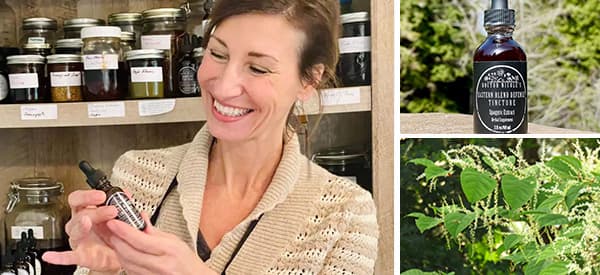
Japanese Knotweed: A Mighty Medicinal Herb
Japanese Knotweed (Polygonum cuspidatum), which is native to East Asia, Japan, Korea, and China, is widely regarded as an invasive weed due to its rapid growth and hardiness. Regardless, it is a powerful medicinal herb. This botanical should be on your radar because it has been shown to help prevent and treat a variety of health problems.
Used for centuries throughout Asia, Japanese Knotweed is beneficial for cardiovascular health, reducing the risk of cancer, improving cognitive function, lowering blood pressure, and healing metabolic syndrome. Additionally, it is often used medicinally for coughs, colds, and respiratory disease. Many have found it to be an effective treatment for Lyme disease as well. Japanese Knotweed is particularly high in resveratrol, a compound with an impressive track record of health benefits.
I’ve included it in my new Eastern Blend tincture because of its exceptional healing properties.
Immune System Modulation
Researchers at the Department of Biomedical and Biotechnological Sciences, University of Catania in Italy discovered that the resveratrol content in Japanese Knotweed played a substantial role in regulating immunity, pro-inflammatory cytokines synthesis, and gene expression.
The effects of this biologically active compound on the immune system have been linked to numerous health benefits for various autoimmune and chronic inflammatory diseases. This review provides a systematic understanding of how resveratrol targets multiple inflammatory components and influences immune cells.
If you have a weak immune system, this mushroom blend is perfect for boosting your immune cells and fighting colds.
Inflammation, Mitochondria, and Disease
Moreover, resveratrol also assists in the prevention and treatment of many chronic diseases related to inflammation, including cancer, obesity, cardiovascular disease, neurodegeneration, and diabetes. The team believes that the high antioxidant content of resveratrol contributes to this anti-inflammatory action.
Resveratrol also improves brain mitochondria function. A study published in Molecular Neurobiology found that the compound reduces mitochondrial impairment in the brain associated with neuroinflammation, cell death, and neurodegenerative diseases such as Alzheimer’s and dementia.
Defeating Bacterial, Viral, and Fungal Infections
It is difficult to find another botanical that has the same level of antimicrobial action as resveratrol. According to a review in the International Journal of Antimicrobial Agents: “Resveratrol displays antimicrobial activity against a surprisingly wide range of bacterial, viral and fungal species. At subinhibitory concentrations, resveratrol can alter bacterial expression of virulence traits leading to reduced toxin production, inhibition of biofilm formation, reduced motility and interference with quorum sensing.”
Japanese Knotweed has also been used successfully in the treatment of Lyme disease where “Polygonum cuspidatum showed strong activity against both growing B. burgdorferi and non-growing stationary phase B. burgdorferi.” The team is unclear as to whether the botanical was effective due to its antimicrobial properties or the effect on the immune system. Both may work synergistically, but more research is needed.
Importantly, resveratrol suppresses the replication of viruses such as dengue, Zika, influenza, and others that cause serious respiratory illness. Not only did the botanical significantly inhibit viral replication during this recent study published in Phytotherapy Research, it also reduced the tissue inflammatory reaction in-vitro. This study is well worth a quick read!
Potent Herbal Relief
Needless to say, resveratrol is a powerful botanical with many medicinal uses, which is why I included Japanese Knotweed in my new Eastern Blend Tincture. The formulation also contains extracts of Chinese Skullcap, Japanese Honeysuckle, and Cordyceps Mushroom. Interested in learning more? Visit the Apothecary today!
You may also like: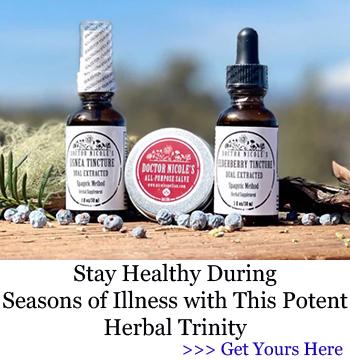
My #1 Go-To Herb for Avoiding Influenza, Colds, and Severe Respiratory Illness
The Mushroom That Got Me Out of The Wheelchair (Video)
Chronic Pain & Sciatica: Natural Remedies That Really Work!
10 Beneficial Plants The Government Doesn’t Allow You To Grow

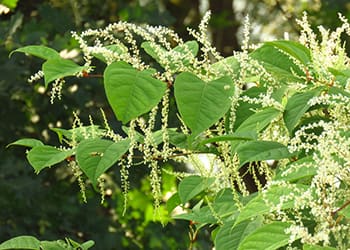
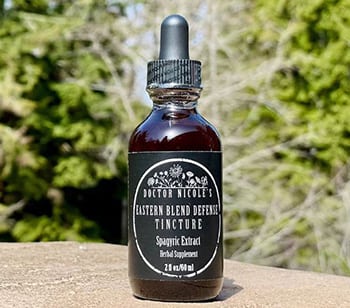
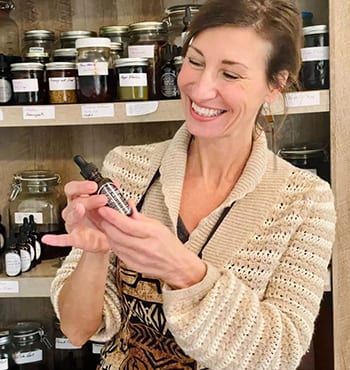
I have this growing wild all over our property and was told how bad it was because it is so invasive. I am so excited to learn that it is beneficial and is medicine. I read that you can eat it when it is a young sprout, can it be dried and be used in teas as well? Do you recommend cooking with it at all?
How specifically can one prepare and use knotweed; which part of the plant?
I would really appreciate an answer on the question above. ♥️
Yes the young shoots can be steamed and are delicious.
The long finger round roots that come off the big main root are easiest to deal with. Wash immediately after foraging to get the dirt off. If they sit too long you’ll find yourself scrubbing cemented soil and risk removing the orangey outer bark which contains some good stuff. Cut small (1/2 in.) and dry. Big pieces will break your blender if you powder it. Can make teas, tinctures, capsules, etc. with the powder. This plant saved my life. I woke up with a 105 fever, stiff neck and pounding headache. The next day my knees blew up like grapefruits. Followed by horribly inflamed adenoids. Every day was a different disease. My son-in-law finally said “it looks like Rocky Mountain Spotted fever or Lymes.” I was using vitamins and herbs up to this point assuming it was viral or bacterial but it wasn’t giving me a complete cure. I lost 25lb. in 4 weeks. I dug the knotweed, dehydrated it and Shazam! I powdered it and put it in ’00’ capsules. Started with 5 and went up to 15 a day. Too much. Threw myself into a cytokine storm. But the Lyme left and I’ve had no (zip, zero) reoccurances. Beware its an invasive species and there’s a $4000 fine (in my area) if your caught planting it. But because of that it’s fairly easy to find. Antibiotics wouldn’t have worked for me. You have to start at the first sign of sickness. I was well into when I started the knotweed. A doctor didn’t believe me when I told her the story a years later. She did a Lyme test. Yep, that’s what it was! It was still in my blood but I’m symptom free. Herbs are amazing. I raised 5 kids using only natural remedies and if you know what you’re doing they won’t fail you.
I am Japanese and I look forward to it every spring. I eat it raw with a little salt or cook it into a Japanese dish. If it is too sour soak in water first but must cut lenth wise or it will pop
Hello DeeDee,
Thank you for your interest in this article!
You can make Japanese Knotweed tea by adding 9 to 30 grams of dried root pieces to 1 liter of water and gently boiling it for 15 to 25 minutes. The tea’s hue is steadily darkening to a deeper crimson. Strain and add honey to taste. Then, throughout the day, consume four equal portions as tea, warm or cold. The young shoots and stems can also be used to make tea. But the highest known concentration of resveratrol is found in roots—the same powerful antioxidant found in red grape skin and red wine.
It is advised to gradually increase the suggested dosage in the first week due to the plant’s high energy output and to give the body time to adjust.
Early spring shoots and leaves are edible, resembling both asparagus and rhubarb. Japanese knotweed shoots are edible raw and have a sour flavor similar to rhubarb, and you can cook them in a similar manner.
Japanese knotweed can be used in a wide range of sweet and savory recipes, such as purees, jams, sauces, fruit compotes, soups, wines, and ice creams, to name a few.
Many blessings and good health!
There are so many fantastic recipes on the plant, do some internet searches. You can even pickle the little babies that come up in the spring time! 😁
Which part are you tincturing?
Leaves?roots?blossoms?
Hello Mary,
You can make a Japanese Knotweed tincture out of its roots, dried and chopped into small pieces.
Half-fill a glass jar with dried chopped-up roots. Add vodka until the liquid level is at least two inches above the root. Stir for a couple of minutes to allow any trapped air to escape.
Place parchment paper between the lid and the jar if using a mason jar. Close the jar tightly. Label the jar with the date and store it away from direct sunlight and heat sources.
For 5 weeks, shake twice daily.
After 5 weeks, strain the mixture through a cheesecloth into a bowl. Hold the cheesecloth over the bowl for 5 minutes to catch all of the liquid.
Place the tincture in a labeled glass jar and keep it in a cool, dark place. Shake well before using. Use as needed up to 3x a day, for 4 weeks.
Many blessings and good health!
It is the root that is best. It’s a long tap root. You boil it then simmer 20 min( root). A Chinese emperor claim to live to be 258 with this herb.
Hi Nicole, I live in Ireland, is there anywhere I can get this tincture blend here?
thanks
Hi Betsy,
We’re afraid that Nicole ships her products within the USA only for the moment. For more inquiries regarding her products, you can use this Contact form:
https://nicolesapothecary.com/pages/contact-us
To buy a Japanese Knotweed tincture, it is best to use Google to find a health store that delivers to your region.
Many blessings and good health!
Japanese knowledge grows all over Ireland. Especially in the west. I’ve seen a lot of it in Mayo and Sligo. It’s so invasive the County Councils employ people to find it and spray it.
Normally you tell how to use the plant and any contraindications, will you be doing an additional article?
Hello Linda,
Thank you for your interest in this article!
You can make Japanese Knotweed tea by adding 9 to 30 grams of dried root pieces to 1 liter of water and gently boiling it for 15 to 25 minutes. The tea’s hue is steadily darkening to a deeper crimson. Strain and add honey to taste. Then, throughout the day, consume four equal portions as tea, warm or cold. The young shoots and stems can also be used to make tea. But the highest known concentration of resveratrol is found in roots—the same powerful antioxidant found in red grape skin and red wine.
It is advised to gradually increase the suggested dosage in the first week due to the plant’s high energy output and to give the body time to adjust.
You can also make a Japanese Knotweed tincture out of its roots, dried and chopped into small pieces.
Half-fill a glass jar with dried chopped-up roots. Add vodka until the liquid level is at least two inches above the root. Stir for a couple of minutes to allow any trapped air to escape.
Place parchment paper between the lid and the jar if using a mason jar. Close the jar tightly. Label the jar with the date and store it away from direct sunlight and heat sources.
For 5 weeks, shake twice daily.
After 5 weeks, strain the mixture through a cheesecloth into a bowl. Hold the cheesecloth over the bowl for 5 minutes to catch all of the liquid.
Place the tincture in a labeled glass jar and keep it in a cool, dark place. Shake well before using. Use as needed up to 3x a day, for 4 weeks.
Dosage: Standardized tablets (Resveratrol): 1-4 tablets three to four times per day. Powder: 1 tbsp. Tincture (1:5, 60% alcohol): ½ to 1 tsp/ day.
Also, early spring shoots and leaves are edible, resembling both asparagus and rhubarb. Japanese knotweed shoots are edible raw and have a sour flavor similar to rhubarb, and you can cook them in a similar manner.
Japanese knotweed can be used in a wide range of sweet and savory recipes, such as purees, jams, sauces, fruit compotes, soups, wines, and ice creams, to name a few.
Contraindications: People who are taking medication, those who are pregnant or breastfeeding, children and teenagers should not take Japanese knotweed products because there is insufficient information on side effects, medication interactions, and safe dosage. This product may interact negatively with certain health and medical conditions, prescription and over-the-counter medications, foods, or dietary supplements. When used prior to surgery or other medical procedures, this product may be hazardous. In patients with non-alcoholic fatty liver disease, side effects such as nausea, vomiting, diarrhea, and liver dysfunction may occur at doses of 2.5 g or higher per day.
Additionally, Japanese knotweed spreads quickly, forming dense thickets that crowd out and shade out native plants. This reduces species diversity, changes natural ecosystems, and harms wildlife habitat.
Many blessings and good health!
Do you have a herbal book…using your Eastern blend tincture?
Hi Donna,
You should check out Nicole’s book, The Forager’s Guide to Wild Foods, in which Japanese Knotweed is mentioned.
You can find the book in our Store.
Many blessings and good health!
Interested in ways of using this plant so any further information would be good. Would it also be effective against COVID if it is so good against respiratory illnesses as described?
Does anybody answer these questions in comments??? It said there was a certain way to prepare it..(click link)…no directions! Soooooo??
Hello Sara,
Thank you for your interest in this article!
You can make Japanese Knotweed tea by adding 9 to 30 grams of dried root pieces to 1 liter of water and gently boiling it for 15 to 25 minutes. The tea’s hue is steadily darkening to a deeper crimson. Strain and add honey to taste. Then, throughout the day, consume four equal portions as tea, warm or cold. The young shoots and stems can also be used to make tea. But the highest known concentration of resveratrol is found in roots—the same powerful antioxidant found in red grape skin and red wine.
It is advised to gradually increase the suggested dosage in the first week due to the plant’s high energy output and to give the body time to adjust.
You can also make a Japanese Knotweed tincture out of its roots, dried and chopped into small pieces.
Half-fill a glass jar with dried chopped-up roots. Add vodka until the liquid level is at least two inches above the root. Stir for a couple of minutes to allow any trapped air to escape.
Place parchment paper between the lid and the jar if using a mason jar. Close the jar tightly. Label the jar with the date and store it away from direct sunlight and heat sources.
For 5 weeks, shake twice daily.
After 5 weeks, strain the mixture through a cheesecloth into a bowl. Hold the cheesecloth over the bowl for 5 minutes to catch all of the liquid.
Place the tincture in a labeled glass jar and keep it in a cool, dark place. Shake well before using. Use as needed up to 3x a day, for 4 weeks.
Dosage: Standardized tablets (Resveratrol): 1-4 tablets three to four times per day. Powder: 1 tbsp. Tincture (1:5, 60% alcohol): ½ to 1 tsp/ day.
Also, early spring shoots and leaves are edible, resembling both asparagus and rhubarb. Young shoots and unfurled leaves can be eaten in spring, before the plant becomes woody, as vegetables or as an asparagus substitute. They can also be used in pies and jam, as rhubarb stems substitute. Soak in cold water for half a day or parboil for best results.
Japanese knotweed can be used in a wide range of sweet and savory recipes, such as purees, jams, sauces, fruit compotes, soups, wines, and ice creams, to name a few.
An easy recipe is the following: Prepare 2 cups of shoots and leaves as above. Add 1 cup each of washed and trimmed asparagus and spinach. Make a dressing of 2 tbsp. melted butter, 1 tbsp. of honey, and 1 tsp. mustard powder. Set aside. Steam the greens and toss in the dressing.
Contraindications: People who are taking medication, those who are pregnant or breastfeeding, children and teenagers should not take Japanese knotweed products because there is insufficient information on side effects, medication interactions, and safe dosage. This product may interact negatively with certain health and medical conditions, prescription and over-the-counter medications, foods, or dietary supplements. When used prior to surgery or other medical procedures, this product may be hazardous. In patients with non-alcoholic fatty liver disease, side effects such as nausea, vomiting, diarrhea, and liver dysfunction may occur at doses of 2.5 g or higher per day.
Additionally, Japanese knotweed spreads quickly, forming dense thickets that crowd out and shade out native plants. This reduces species diversity, changes natural ecosystems, and harms wildlife habitat.
Many blessings and good health!
Look at above comments. She explains how to use and create tinctures etc
How about some info as to how, where, e-mail etc. Some of the above information would be nice
Look at above comments. She explains how to use and create tinctures etc
So, basically, this “post” is just a long winded ad for your products. No answered questions, just bare “information”, no recipes to use, instructions on what parts to use, etc. : nothing else.
So disappointing.
Look at above comments. She explains how to use and create tinctures etc
Observations: 98% of the herbs listed on this website claim to be helpful for diabetes. Where are your sources? I note that Japanese Knotweed also “assists in the prevention and treatment …..including …..diabetes”
it contains resveratrol….so do grapes. Grapes have been promoted for a long time: consuming red wines or grape juice for the resveratrol.
So, what DOESN’T help with the prevention and treatment of diabetes?
Hello Carol,
Thank you for your comment.
We recommend reading the resource below for extensive information on Japanese Knotweed:
https://www.ncbi.nlm.nih.gov/pmc/articles/PMC8705504/
Many blessings and good health!
Nicole,
I have asked you many times if there is any nutritional value or medicinal value in Myriophyllum Aquatica, and have never received a reply. There is no information on this invasive weed anywhere I have searched. It grows very similar and is in the same family as Hydrilla Verticillata which is considered a super food. All I know is that it is edible in New Zealand. I live in nw Oregon, not far from you.
Hi Alfred,
Thank you for your comment.
We’re afraid we do not know of any documented medicinal benefits of Myriophyllum Aquatica. But it is indeed edible for humans. Young shoot tips are usually cooked and used as a vegetable.
Many blessings and good health!
Hi nicole
Thank you for this important post.
Can you please explain how to make a 1:5 Tincture in 60% alcohol?
Thank you
Meir
Hi Meir,
1:5 is the Mass to Volume ratio or 1 part herbs to 5 parts alcohol.
Begin by weighing your plant matter. Once the herbs are weighed out, place them into the jar. Add the alcohol and give the mixture a good shake.
**Note that stronger alcohol types can be diluted with distilled water to reach a lower alcohol content by volume.
The appropriate alcohol strength for your tincture will depend upon the qualities of the plant material being used. Stronger is not always better!
TIPS FOR MATCHING YOUR ALCOHOL STRENGTH TO THE HERB BEING TINCTURED:
40% to 60% alcohol by volume (80- to 90-proof vodka)
• “Standard” percentage range for tinctures.
• Good for most dried herbs and fresh herbs that are not super juicy.
• Good for extraction of water-soluble properties.
67.5% to 70% alcohol by volume (half 80-proof vodka and half 190-proof grain alcohol)
• Extracts the most volatile aromatic properties.
• Good for fresh, high-moisture herbs like lemon balm, berries, and aromatic roots.
• The higher alcohol percentage will draw out more of the plant juices.
85% to 95% alcohol by volume (190-proof grain alcohol)
• Good for dissolving gums and resins but not necessary for most plant material.
• Extracts the aromatics and essential oils bound in a plant that don’t dissipate easily.
• This alcohol strength can produce a tincture that’s not easy to take and will also dehydrate the herbs if used for botanicals beyond gums and resins.
Label the jar with name of herb, alcohol/liquid type, and date. Place the jar in a cool, dark place.
Many blessings and good health!
How useful would the ‘forage’s guide book’ be for someone living in the uk?
Hi Ange,
Thank you so much for your interest in The Forager’s Guide to Wild Foods.
Most of the plants can be found or grown in the UK too.
However, The Forager’s Guide to Wild Foods can be purchased in digital copy only at the moment, if you live in Europe.
We are working on a European edition as we speak. If you wish, you can order the book in digital copy only at the moment (North American edition):
https://wildplantsguide.com/book/?hop=lostherbs
Once the book is available in physical copy too, we can send you an email and let you know. You can then pay for shipping and handling only (if you have already purchased the digital copy). Just let us know.
Many blessings and good health!
Is alcohol the best option for making a Japanese Knotweed tincture? I have Lyme and would like an easier way to use then adding the powder to water. Bulk powder is far cheaper than buying capsules…
I grow a variegated variety of Japanese knot wood. Do you know if this variety has the same properties!!! It looks exactly the same but leaves are green with beige/white mixed in. Thanks in advance!!
Hello, I started some tincture out of the Knotweed but used fresh green roots. Is this going to be alright? I have read that you use dried roots for a tincture. Thank you.